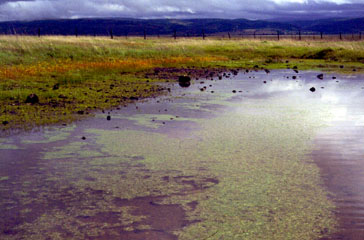Vernal pools are beautiful. Vernal or ephemeral pools are temporary pools of water that offer protection to juvenile amphibians and insects. They are created when snow melts, and a large amount of the water gathers in a single place. Since vernal pools usually develop inland they’re completely free of predatory fish. We don’t typically think of little freshwater fish as fierce predators, but to insects and amphibians, especially young ones, they may as well be what an owl is to a mouse. Vernal pools are home to many rare species of frogs, toads, salamanders, crustaceans, bacteria, as well as many rare species of flora. Vernal pools can be found in places all over the world, but they’re becoming rarer and rarer due to agriculture and urbanization. Over 90% of California’s vernal pools have been destroyed, and the sad thing is most of the people destroying them didn’t even know they were doing something wrong.
Luckily Massachusetts has laws that protect vernal pools, but it’s not that simple. People in Massachusetts still destroy vernal pools because of lack of awareness, or simply blatant disregard.
There are a number of laws concerning vernal pools in Massachusetts. Although originally protected under the Massachusetts Wetlands Protection Act, vernal pools are also protected by Title 5 of the Massachusetts Environmental Code, Section 401 of the Federal Clean Water Act, the Massachusetts Surface Water Quality Standards which relate to Section 401, and the Massachusetts Forest Cutting Practices Act. For more information concerning the laws involving vernal pools is at www.mass.gov. Once a vernal pool has been destroyed, it can’t be brought back, once it’s gone…it’s almost certainly gone for good. Numerous experiments have been done trying to create artificial vernal pools, and many have failed. It’s possible to create, a vernal pool, but it’s very difficult to do.
There are ways ordinary citizens can help protect vernal pools. In Massachusetts vernal pools can only be protected if they’re certified. The process by which vernal pools are certified relies on volunteers that submit evidence of a vernal pool. I encourage you to go out, to try and find a vernal pool. Even if it’s already certified they’re amazing to see.
Although I wasn’t able to interview him in person I have exchanged multiple emails with Wayland’s conservation land manager Brian Harris, I asked him some questions and here are his answers:
“How many vernal pools are there in Wayland?”
Currently the town has 3 “certified” vernal pools. A certified pool is one that meets the criteria set forth by Massachusetts Fish and Wildlife Service. One of my goals as conservation land manager last year was to get out there and find more vernal pools and map them accordingly. I get extremely busy in the spring and just didn’t have the time to properly survey them. However we have some vernal pools out there that haven’t been submitted to the state whom is responsible for overseeing certified pools(see below)
“How many vernal pools in Wayland have been destroyed?”
-I have no idea the numbers of vernal pools that have been destroyed. If I looked at historical aerial surveys when technology was sharp enough to identify a vernal pool I imagine the number would be extremely high. Before Wetland regulations were put in place to conserve areas of critical habitat like vernal pools the destruction was probably vast, but again to reiterate I personally do not have this data.
“Why are vernal pools important?”
– Per a field guide to vernal pools by Kenney and Burne:
“Vernal pools are indispensable for biodiversity, both locally and globally. For a species with a wide distribution individual vernal pools are essential to the local population. Eliminate those pools and the population of that organism will die out in that area. For a species with narrow distribution a specific vernal pool might be the only place on earth that organism is found. If the pool is destroyed that species becomes extinct.”
They are also so susceptible to disturbance, destruction and pollution and are in such short supply that its critical to preserve what few pools remain for these organisms
“What are some species of vernal pools?”
The following species are obligate species of vernal pools:
Wood frog, spadefoot toad, spotted salamander, blue-spotted salamander, Jefferson salamander, marbled salamander and fairy shrimp
Obligate species refers to in this case an organism dependent on a particular habitat to be able to breed.
“How can people help protect vernal pools?”
-become knowledgeable about vernal pools and spread the knowledge
-become involved in local governments such as conservation committees planning boards and similar regulatory groups that make decisions which affect land use and vernal pools
-similarly become involved with and support regional and nationwide environmental or biological organizations that promote environmental protection species protection and land preservation
Vernal pools are some of the most beautiful and rare natural habitats, and we should do everything we can to protect them. I’m Chase Dallin and I hope you enjoyed and learned something from reading this article of mine. Bye!

